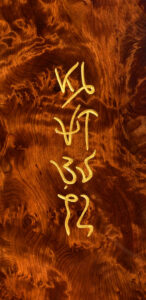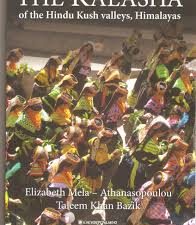World Endangered Writing Day was born out of a suggestion by David Crystal, the author of The Cambridge Encyclopedia of Language, and many other books on language topics.
He was reading through the manuscript of my new book Writing Beyond Writing: Lessons from Endangered Alphabets, and came to the passage where I say that in traditional Balinese culture one day a year, the day consecrated to Saraswati, the goddess of wisdom, Balinese revere their books, and writing itself.

Nothing written may be destroyed, or even a letter crossed out. Each household takes out its books (which in Balinese tradition are oblong pages of palm leaf, written on with a stylus and then bound between wooden slats), dusts them off, repairs them, and places them in a small shrine to Saraswati to act as the representation of the goddess, to whom eighteen offerings are made, one for each of the letters of the Balinese alphabet.
“This landscape, so unlike our own,” I wrote, “is what it looks like when a culture recognizes the value and importance of writing beyond being a mere handy means of conveying information. Do I need to point out that we in the West have no day dedicated to knowledge, learning, wisdom, and books in particular?”

And David Crystal wrote in the margin, “You should invent one.”
A little background. I created the Endangered Alphabets Project in 2010 after discovering that an appallingly high percentage of the world’s scripts (at the time I thought 30%, but later discovered closer to 90%) of the world’s scripts are close to extinction.
I began by carving short pieces of text in different minority scripts, exhibiting them, and lecturing on this crisis of script loss, and how deeply it affects a culture when it is forced to abandon its traditional writing system.
Subsequently I went to Bangladesh and met people from ethnic groups that had, in fact, been denied the use of their own scripts, and the Endangered Alphabets became more activist, creating games and educational materials to support threatened scripts and partnering with script revivalists.
The more I explored and researched, the more I found that not only is each individual person’s handwriting an expression of their character, their mood, even their level of energy at the time, but each culture’s form of writing is equally self-expressive. Every script is shaped over time by the people who use it, and is as much an expression of their culture as their music, art, or dance.
For example, we know of one or more scripts …
- whose every letter has a secret mystical meaning;
- that united entire minority communities against colonizers;
- that are taken so seriously that a scribe must recite specific mantras before beginning to write, before making a correction, even before opening a book;
- that were created as the result of dreams, visions, or divine commands;
- that were devised and used solely by women, largely in secret;
- that were so banned that a writer who used them could be imprisoned and have all his property confiscated;
- that are worshipped at household shrines in ceremonies in which the letters are written in chalk, then the chalk is washed off and the chalk-water is drunk to imbibe the sacred power of the letters;
- that were written or incised in bark, palm leaves, bamboo, buffalo horn, animal hide, stone, wood, and even human skin, as tattoos. The very shapes of their letters were influenced by the tools and materials available, and so reflect not only their history by their landscape;
- that have such spiritual significance that if someone in the community dies without having learned to read and write their script, the priest sits beside the corpse in the period before cremation and teaches in the alphabet so it is prepared for the afterlife.
Getting people in mainstream culture to pay attention, however, faced three major obstacles:
- Most people in the West use only one script, have virtually no knowledge of or need for other scripts, so they have no sense of the problem.
- The fact that the Latin alphabet is used by so many people—more than every other writing system combined—paradoxically means it has no home, no sense of local identity. We understand minority languages—Catalan, Basque, Welsh—and their meaning to their user community, but we have no sense at all of the profound connection between a minority community and its writing.
- Scholars of linguistics study spoken language—in great detail—but have essentially exiled written language from serious consideration. Hence we have seen the growth of a movement to study, then to revitalize endangered languages, but no parallel movement concerned with endangered forms of writing.

The aim of World Endangered Writing Day, then, is to try to cross that bridge by bringing together (the very few) scholars who study writing with community activists who are trying to revive their cultures by reviving their scripts.
Interestingly, this also involves challenging the very definition of writing, because the colonial-era definition of writing deliberately excluded a wide variety of non-phonetic written forms out of the belief that they were inferior, childish, or primitive. Recent research shows how wrong (and racist) such views were.
The day will also involve a series of other related activities:
- video reports from around the world as various communities work to revive their scripts;
- an awards ceremony for people and organizations engaged in such activities who typically are ignored or even opposed and deserved recognition;
- a giveaway of books in minority scripts;
- a Second Wave relaunch of our Atlas of Endangered Alphabets (endangeredalphabets.net), adding profiles of another 100 minority and indigenous scripts;
- games and puzzles connected to endangered alphabets;
- and it will be the official publication date of my book Writing Beyond Writing.
Our goal is to open two doors, just a little, that with luck will in time lead to two outcomes.
One is to expand the definition of linguistics to include the study and appreciation of writing and written language.
The other is to fulfill the provisions of the 2008 U.N. Declaration on the Rights of Indigenous Peoples, Article 13:
Indigenous peoples have the right to revitalize, use, develop and transmit to future generations their histories, languages, oral traditions, philosophies, writing systems and literatures, and to designate and retain their own names for communities, places and persons.
As far as I know, not a single country in the world is fully committed to that outcome. Hence the first-ever World Endangered Writing Day: January 23rd, 2024.

Tim Brookes is the founder of the Endangered Alphabets Project and the creator of World Endangered Writing Day. His most recent book is Writing Beyond Writing: Lessons from Endangered Alphabets.








I stumbled over this (popular science mediation) article not long ago: https://www.thecollector.com/unusual-writing-systems/
Thank you for writing about World Endangered Writing Day! As a fellow writer, I appreciate the importance of raising awareness about the decline of endangered languages and the impact it has on cultures around the world. It’s crucial that we take action to preserve these languages and the rich cultural heritage they represent. Keep up the great work!